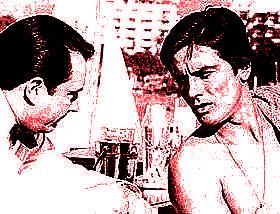Film Review

Interestingly, Jean-Louis Trintignant was originally slated for the part of the younger crook, Francis. When he learned about the film, Alain Delon persuaded producer Jacques Bar to give him the role, and even agreed to waiver his fee in exchange for a percentage of the profits in three countries - China, Japan and the USSR. (As the film proved to be a major hit in Japan, Delon ended up earning ten times more than Gabin.) By this stage in his career, Delon was already an internationally recognised star and was fast becoming one of the biggest screen actors in French cinema. He had already worked with some of the great Italian cineastes - Luchino Visconti on Rocco and His Brothers (1960) and Michelangelo Antonioni on L'Eclisse (1962) - but hadn't yet established the chilling screen persona that would make him a cinema legend. Mélodie en sous-sol was an important stepping stone between the French films that had brought Delon to the public's attention - notably René Clément's Plein soleil (1960) - and the hard-boiled gangster films of the late '60s and 1970s, films such as Melville's Le Samouraï (1967) and Jacques Deray's Borsalino (1970).
If Delon was still finding his feet, the same was certainly not true of Jean Gabin. The latter was safely ensconced as a cinema icon and massive mainstream cinema attraction, now as comfortable playing taciturn gangsters and ruthless patriarchs as he had been with heroic romantic roles in his early career. Gabin also featured in a number of popular comedies, one of which he had only just made with Verneuil - Un singe en hiver (1962) - starring opposite another young actor who would come to rival Delon in popularity, Jean-Paul Belmondo. Gabin and Delon are evenly matched in both talent and charisma but make a striking contrast. Gabin is like a rock - solid, implacable, but with a genteel elegance. Delon, by contrast, is like a wild panther - virile, sleak and deadly. Whilst Delon exudes menace through his vitality and physicality, Gabin does so with virtually no effort at all, through his physical presence alone. It is interesting that, in the course of his career, Alain Delon's screen persona would evolve to resemble that of Gabin in his later gangster roles - colder, more controlled, a shard of twisted humanity within a granite shell. Gabin and Delon would work together on two subsequent films: Henri Verneuil's Le Clan des Siciliens (1969) and José Giovanni's Deux hommes dans la ville (1973).
Mélodie en sous-sol was adapted by Albert Simonin and Michel Audiard, two of French cinema's best-known screenwriters of this era. Audiard actually had very little input into the script, but contributed some of the film's most memorable dialogue exchanges. Another strength of the film is Michel Magne's evocative jazz score, which not only helps to build the tension but also gives it its modernist feel, perfectly complementing the fluid camerawork and stylish mise-en-scène. Magne had an extraordinary career and many of his film scores are works of art in their own right, including his haunting theme for the Angélique films of the late 1960s. Magne's score for Mélodie en sous-sol is one of his richest and classiest, offering echoes of Elmer Bernstein's music for The Man with the Golden Arm (1955). With such a wealth of artistic input on both sides of the camera, it is not hard to see why Mélodie en sous-sol is one of Henri Verneuil's most popular films and an enduring classic of the gangster thriller genre. Is there a caper movie with a more inspired ending than this one?
© James Travers 2011
The above content is owned by frenchfilms.org and must not be copied.
Film Synopsis
Monsieur Charles has only been out of jail five minutes after completing his last stretch before he begins planning his next robbery. This, he resolves, will be his last big job. If all goes well, he intends retiring to Australia with his wife Ginette. He has his friend Mario to thank for the idea of raiding a casino at Palm Beach in Cannes. Mario is not well enough to do the job himself so Charles takes charge of the operation. He recruits a delinquent young man, Francis Verlot, to assist him, and a mechanic named Louis to drive the getaway car. Charles leaves nothing to chance. He carefully acquaints himself with the territory before the robbery and makes meticulous preparations.The plan is for Francis to gain access to the casino, with the help of Brigitte, a young dancer he has seduced. Unfortunately, Francis turns out not to be the most dependable of criminal associates. He almost scuppers the entire operation by going off the handle on learning that Brigitte has a rich admirer. Miraculously, the heist comes off as planned and Monsieur Charles walks away with a cool ten million francs in banknotes. But before he can make his getaway, Francis manages to get his photograph in the newspapers. To avoid being caught with the money in their possession, the crooks hastily throw the sacks containing their booty into a swimming pool. This proves to be another fatal mistake...
© James Travers
The above content is owned by frenchfilms.org and must not be copied.
Similar Films
Here are some other films you may enjoy watching:Other related links:
Film Credits
- Director: Henri Verneuil
- Script: Michel Audiard (dialogue), Zekial Marko (novel), Albert Simonin
- Cinematographer: Louis Page
- Music: Michel Magne
- Cast: Jean Gabin (Charles), Alain Delon (Francis Verlot), Claude Cerval (Le commissaire de police), Viviane Romance (Ginette), Henri Virlojeux (Mario), Jean Carmet (Le barman), José Luis de Vilallonga (M. Grimp), Rita Cadillac (Liliane), Jimmy Davis (Sam), Dominique Davray (Léone), Dora Doll (Countess Doublianoff), Germaine Montero (Mme Verlot), Maurice Biraud (Louis Naudin), Carla Marlier (Brigitte), Marc Arian (L'autre comptable), Henri Attal (Le copain de Francis), Jacques Bertrand (Le comptable de Grimp), Georges Billy (Un passager du train), Charles Bouillaud (Un voyageur), Christian Brocard (Le livreur)
- Country: France / Italy
- Language: French / English
- Support: Black and White
- Runtime: 103 min
- Aka: The Big Snatch ; Any Number Can Win
The brighter side of Franz Kafka

The best French war films ever made

